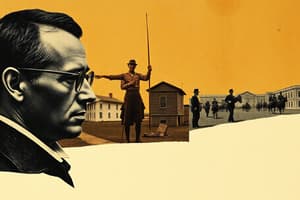Podcast
Questions and Answers
What was the primary benefit of the corporate form for railroads?
What was the primary benefit of the corporate form for railroads?
- It allowed for a larger management bureaucracy to be developed. (correct)
- It increased individual ownership of the railroads.
- It limited the number of entrepreneurs involved in the industry.
- It minimized the need for coordination among railway lines.
How did railroads indirectly stimulate the economy?
How did railroads indirectly stimulate the economy?
- By purchasing large quantities of goods from other industries. (correct)
- By limiting production to local markets.
- By decreasing demand for customized tools.
- By reducing the need for coal as a fuel source.
What role did Cornelius Vanderbilt play in the railroad industry?
What role did Cornelius Vanderbilt play in the railroad industry?
- He invented the steam locomotive that powered the railroads.
- He primarily focused on ferry services and neglected railroads.
- He was the first to establish a railroad union.
- He consolidated and operated the New York Central rail line. (correct)
What was a major impact of the railroads on market development?
What was a major impact of the railroads on market development?
How did railroads affect the development of undeveloped areas?
How did railroads affect the development of undeveloped areas?
Flashcards
Railroad's impact on management
Railroad's impact on management
Railroads required large, coordinated management bureaucracies to operate efficiently and safely, but these bureaucracies only managed enterprises already developed.
Entrepreneurial role in Railroads
Entrepreneurial role in Railroads
Railroad development was mostly driven by entrepreneurs like Cornelius Vanderbilt, who started in related industries (e.g ferry service) and later expanded into railroads during war years.
Railroad's effect on other industries
Railroad's effect on other industries
Railroads boosted other industries like steel and coal by purchasing their products—and railroads became significant customers of these industries.
Railroad's impact on national markets
Railroad's impact on national markets
Signup and view all the flashcards
Railroad's effect on un-developed areas
Railroad's effect on un-developed areas
Signup and view all the flashcards
Study Notes
A Nation Transformed
- The Civil War marked a significant turning point in American history, shifting the nation from its early agrarian republic to a more unified and powerful nation-state.
- The war's effects were widespread, impacting economics, political and social life, culture, and the nation's self-consciousness.
- The nation transitioned from a decentralized republic to a more powerful nation-state.
- This shift was accompanied by significant new forces, which were both exhilarating and threatening.
- The Grand Review of the Union armies in 1865 was a monumental spectacle, marking the conclusion of the Civil War.
- The review involved two hundred thousand soldiers marching through Washington, D.C., over two days, a significant display of national unity and power.
- Despite this show of unity, the nation still grappled with questions about the balance of power and authority.
- The growth of industrial power in the United States was significant, surpassing that of other major European powers in the late 19th century.
- Railroad expansion and technological development drove this industrial growth and fostered national markets.
- The development of large corporations and the corporate form of business helped facilitate this expansion, though also brought new challenges for workers and social structures.
- The emergence of large corporations, particularly in the railroad and steel industries, raised concerns about the concentration of power and potentially monopolistic practices.
The Impact of the Industrial Revolution
- The rapid expansion of American industrial power led to major changes in the national economy, transforming the United States.
- Access to natural resources, a growing population, and readily available investment capital fueled this industrialization.
- America had access to copious sources of capital, and a well-developed transportation network facilitating profitable investment, which were vital.
- Technological innovations were crucial to the expansion of the American economy.
Urbanization
- The industrialization of America caused a major shift toward large urban areas.
- The growth of cities was rapid and dramatic.
- This growth resulted in the development of dense, often unhealthy urban environments, contrasted with rural farming.
- The concentration of people in cities also caused serious social and economic issues, such as disease, crime, and poverty.
Immigration
- There was a massive increase in immigrants to America and a significant shift in the composition of immigrants.
- Immigrants provided a labor source for growing industries.
- This massive influx of people from many parts of the world, which increased dramatically in the period, led to the transformation of the American nation, adding to its diversity.
- These new waves of immigrant challenged the notion of a unified American identity.
Studying That Suits You
Use AI to generate personalized quizzes and flashcards to suit your learning preferences.




